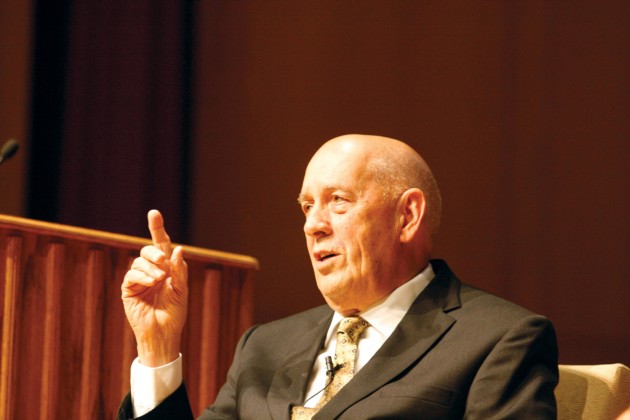
Dick Vitale, ESPN correspondent, introduced Bill Rasmussen '54 to a crowded Kresge Auditorium Thursday night via video call.
"I thank him every day. He's given me a heck of a living and a heck of a life," Vitale said. "He's awesome baby!"
Rasmussen, who is now 82, stood for 40 minutes retelling how he created ESPN. Charisma spilled out of his mouth from the moment he took the stage.
"Too bad Dick doesn't have any enthusiasm in his voice," Rasmussen joked of the notoriously excitable Vitale.
ESPN rose up from having eight employees when it first aired September 7, 1979 to employ some of the most recognizable faces in sports reporting: Chris Berman and Stewart Scott. ESPN's campus now sits on 127 acres of land with the original building and satellite, which no longer functions.
Rasmussen stuck to the business model of FACTS: Financing, Advertising, Content, Technology and Subscribers.
To get prospective buyers to purchase ESPN into their homes Rasmussen created a graphic demonstrating how the newly-formed cable would get from the satellite to their homes. Green and red light, moving through tubes on a black screen conveyed the process.
"They even signed up. Can you believe that?" Rasmussen said. "I think third graders now can make better graphics than that."
In the early days, things didn't always run smoothly.
"One thing he didn't mention was the early programming was just awful," John Long '70 said. "There was sheep herding, third and forth rate tennis tournaments, obscure European sports."
ESPN could not air games they taped that day until 10 p.m. Back when games were stored on video tapes, production workers had to physically place the tapes into the receiver to broadcast. Once, the third and fourth quarter tapes were swapped - the fourth played before the third.
"No one called in," Rasmussen said of the incident.
Since then ESPN has gained the rights to 52 percent of the sports market having ESPN, ESPN 2, ESPN U, ESPN Classic, ESPN 3D, ESPN Radio and airs Monday Night Football. Disney now owns ESPN and it accounts for 45 percent of its total revenue.
Despite rejection from seven of eight investors, and a $9,000 advance on his personal credit card to finance the network, Rasmussen never doubted himself or the product. Finally Getty Oil invested in ESPN.
"I didn't have to [doubt] because I knew I was going to succeed," Rasmussen said. "I was a real optimist. We kept going."
The national basketball championship game in 1980 between Larry Bird's Indiana State and Magic Johnson's Michigan State influenced the great success of the company. ESPN had the rights to the game, and the demand for live sports increased.
"The power of the fan made ESPN," Rasmussen said.
Rasmussen graduated from DePauw in 1954 with a degree in economics. After graduation, Rasmussen served in the United States Air Force, then earned his M.B.A. from Rutgers University.
"It's a classic example of a liberal arts education," said Page Cotton DePauw's former Athletic Director. "You don't learn that in one class."
Cotton said he listens to ESPN radio while in his car on his satellite radio.
Junior Paul Mpistolarides attended the lecture and said he typically watches Sports Center 15 minutes before class every day.
"I thought it was cool hearing a speaker that the focus was he took a huge risk at something," Mpistolarides said.
This week and next, Rasmussen will give talks and be available to meet with students.
"From a recruiting stand point he is important," said David Bohmer, director of the Media Fellow Program. "The subliminal message is: see what can happen if you come to DePauw."


